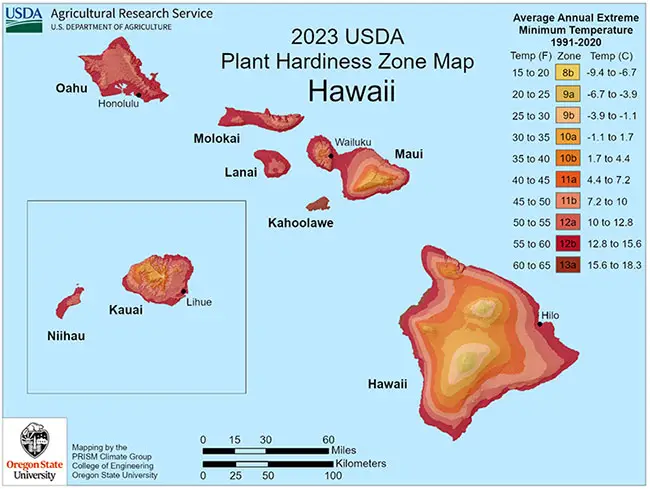
With consistently delightful tropical weather year-round, Hawaii offers an ideal environment for cultivating a wide variety of palm trees. The state boasts a tropical climate marked by hot summers and warm winters.
Summer temperatures typically range from 85-90°F (29-32°C), while in the winter months, they remain pleasantly mild, hovering between 79-83°F (26-28°C).
Hawaii experiences abundant rainfall and winds. Interestingly, even the state’s three highest mountains occasionally receive snowfall during the winter months.
While the hurricane season runs from June through November, it’s worth noting that Hawaii is seldom directly impacted by true hurricanes. Instead, the state is more frequently affected by tropical storms originating off the coast of Mexico.
The USDA hardiness zones in Hawaii encompass a broad range, extending from 9a to 13a.
Growing Palm Trees in Hawaii
Because Hawaii enjoys consistently warm weather, the possibilities for palm tree varieties to grow there are virtually endless. Here are some of the palm trees that can successfully grow in Hawaii:
- Bottle Palm Tree – Zones 10a – 11 (30 to 35F)
- Canary Date Palm Tree – Zones 8b – 11 (15 to 20 F)
- Carpentaria Palm Tree – Zones 10a – 11 (30 to 35 F)
- Coconut Palm Tree – Zones 9a – 11 (20 to 25 F)
- Fiji Fan Palm Tree – Zones 10a – 11 (30 to 35 F)
- Florida Thatch Palm Tree – Zones 10a – 11 (30 to 35 F)
- Majesty Palm Tree – Zones 9b – 11 (25 to 30 F)
- Ponytail Palm Tree – Zones 8b – 11 (15 to 20 F)
- Pygmy Date Palm Tree – Zones 8b – 11 (15 to 20 F)
More Palm Trees»
Major Cities in Hawaii
- Honolulu – Hardiness Zone 11a

What’s the difference between Hawaii’s palms and Florida’s palm trey